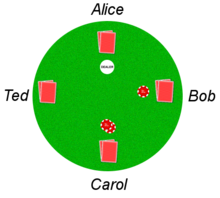Side pot
The side pot (not to be confused with split pot ) is a possible option in a game of poker .
If a poker player wants to bet all of his chips , i.e. he goes all in , but wants to bet at least two opposing players over this amount, an additional pot is set up in parallel to the main pot , which is called a side pot . The player who is all in receives a maximum of the main pot , but not the side pot . If neither player raises all in , no side pot is opened and the winner is entitled to the entire pot.
If a side pot is opened, the all-in player can no longer intervene in the game, but may not yet reveal his hole cards .
The other players who the all in at least get called were allowed to put even more regular. In tournaments, however, you usually only check until the end of the hand, because you want to push the player who is all in from the table and these chances increase with the number of players with several players.
If after the fifth card is checked or all bets have been called, all players must show their cards. If the player has the best hand with all of this , he receives the main pot . The opposing player with the second best hand receives the side pot . However, if the player with all in does not hold the best hand, the main pot and side pot go to the opposing player with the best hand.
Note : It is also possible to build several side pots .
Example with a side pot
Alice, Bob, Carol and Ted sit around a table. Alice has € 400 in chips , Bob, Carol and Ted have € 500 each. This example dispenses with individual betting rounds and blind stakes.
| action | Main Pot | Side pot |
|---|---|---|
| Start of the round. The main pot is empty. A side pot has not yet been formed. | 0 € | - |
| Alice moves all in, with € 400 in the main pot. | 400 € | - |
| Bob goes all in too. His stake exceeds Alice stake by € 100. This "overhang" goes into the side pot. | € 800 | 100 € |
| Carol goes all in. Her stake is also higher than Alice's stake. | 1200 € | € 200 |
| Ted goes all in. His stake is also bigger than Alice's stake. | 1600 € | € 300 |
If Alice has the best cards, she wins the main pot. She has no claim to the side pot. This goes to the person who has the second best cards.
If, however, either Ted, Carol or Bob hold the best cards, they win both the main pot and the side pot.
Example with two side pots
Alice, Bob, Carol and Ted sit around a table. Alice has € 400 in chips, Bob € 500. Carol and Ted have € 600 each. This example dispenses with individual betting rounds and blind stakes.
| action | Main Pot | Side Pot 1 | Side Pot 2 |
|---|---|---|---|
| Start of the round. The main pot is empty. A side pot has not yet been formed. | 0 € | - | - |
| Alice moves all in, with € 400 in the main pot. | 400 € | - | - |
| Bob goes all in too. His stake exceeds Alice stake by € 100. This "overhang" goes into the side pot. | € 800 | 100 € | - |
| Carol moves all in. Her stake is higher than the last called all in. So a separate side pot has to be created. | 1200 € | € 200 | 100 € |
| Ted goes all in. His commitment is the same as Carol's commitment. | 1600 € | € 300 | € 200 |
If Alice has the best cards, she wins the main pot. She has no claim to the side pots. The first side pot goes to the person with the second best cards. The second side pot goes to Carol or Ted - whoever has the better cards.
If Bob wins, he receives the main pot and the first side pot. The second side pot goes to Carol or Ted.
If, on the other hand, Carol or Ted holds the best cards, he / she wins both the main pot and both side pots.
